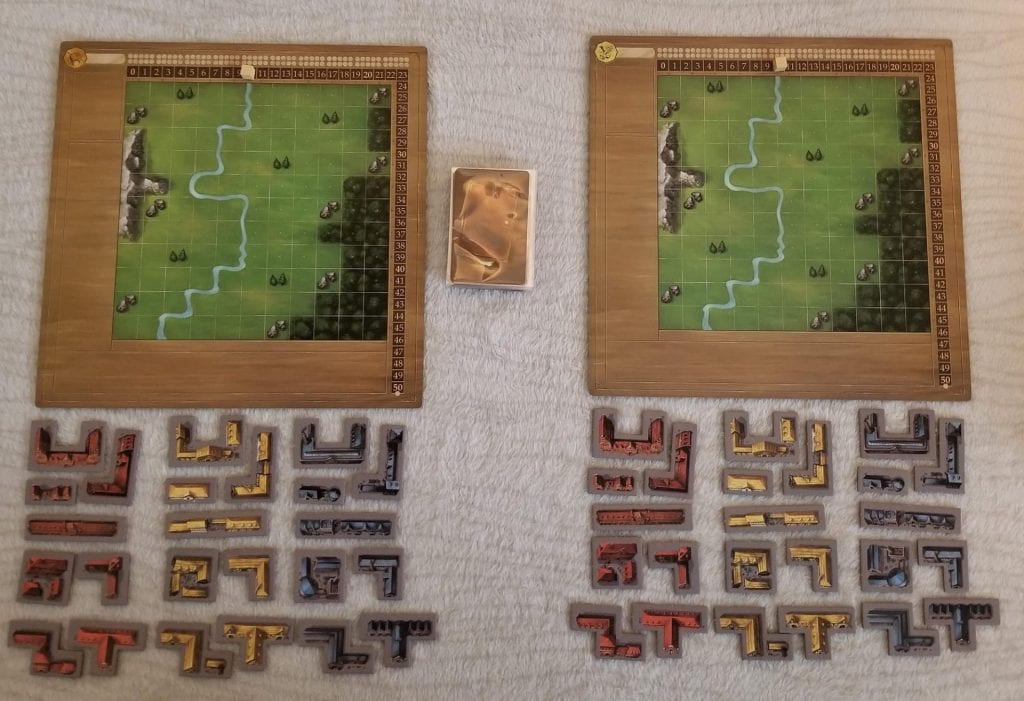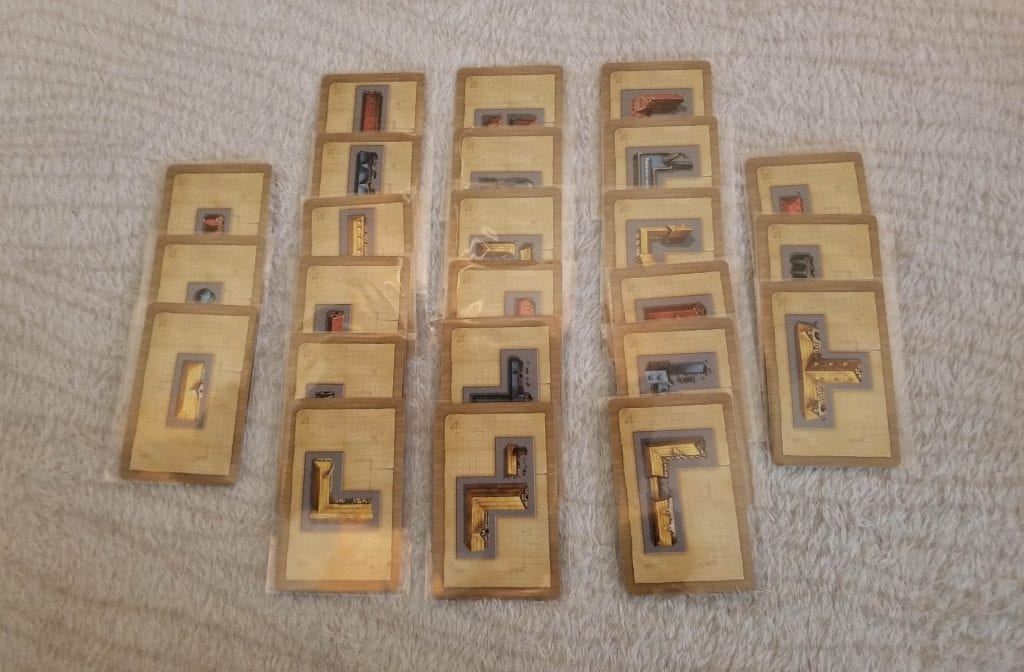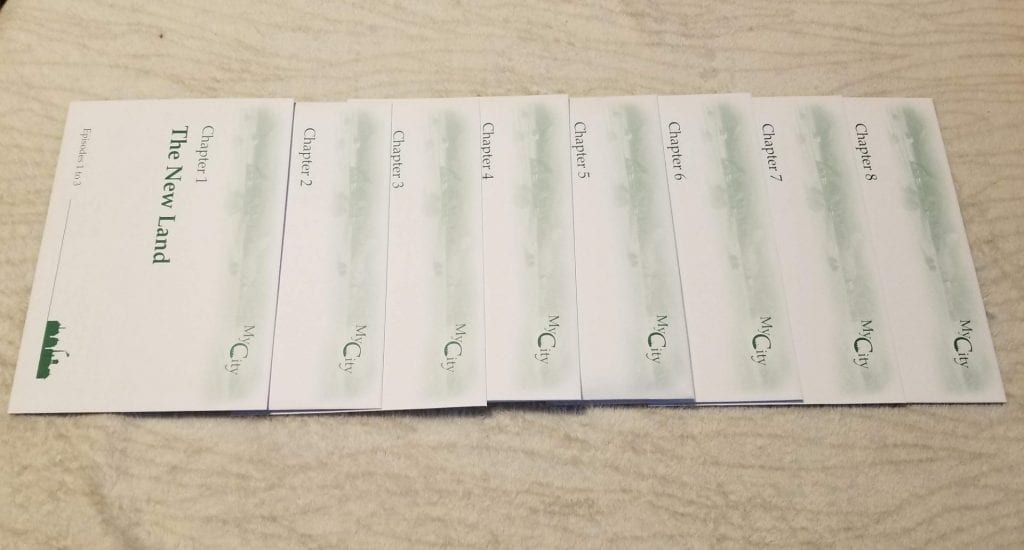Disclosure: Meeple Mountain received a free copy of this product in exchange for an honest, unbiased review. This review is not intended to be an endorsement.
Welcome to the countryside, friend. Gaze upon the land before you and imagine not what currently is, but what may one day be.
Nestled between a mountain range to the west and a thick forest to the east lies a nameless, untouched valley with a river bisecting it. Natural resources abound: water, fertile soil, wood, stone. There are even rumors of gold deposits in the surrounding hills. It’s the perfect location to start a community and watch it thrive. It’s the perfect place for you to start your city.
In Reiner Knizia’s My City, nominated for the 2020 Spiel des Jahres, each player takes on the role of a city developer trying to put together the highest scoring city. Each player begins the game with an identical set of polyomino tiles in 3 different colors, as well as a player board; both of which will be theirs for the entirety of the legacy campaign. There’s also a shared deck of cards with each card featuring an image of one of the polyomino tiles on it.
The rules for My City are pretty simple. During each game the deck of cards is shuffled and then the cards are revealed one at a time. When a card is revealed, each player will add the corresponding tile to their developing city if they are able and want to. Not playing a tile will cost you points, so it is almost always more preferable to play one than to not play one.
“Almost always” is the key phrase in that last sentence. My City is a legacy game that spans over the course of 8 chapters divided into 8 different envelopes (3 episodes per chapter). Each episode in My City introduces new story lines, new scoring concepts, and even some new components that will have a direct effect on how the players will approach the tile placements during each game.
My City can also be played as a standalone game. On the backside of each unique player board (they don’t start out unique, but it doesn’t take long for them to become that way) is the same countryside layout. This standalone version uses the rules gleaned from episodes 1-10, so it’s recommended you don’t try it out until you’ve gotten at least that far in the campaign. Or it should be fine if you’re playing with random people that aren’t planning to play through the legacy game.

Just to give you an idea of how the game might change from one episode to the next, I’m going to give you a brief overview of episodes 1 through 3. If you want to completely avoid spoilers, though, don’t click the button below. You can just delve right into what I think about My City.
Episode 1
At the beginning of Episode 1, you find yourself looking down at an empty player board. At the top left of the board is a spot for you to give your city a name along with an icon in a hexagon. This is your icon for the rest of the game. It matches up with all of the pieces that belong to you. To the right of this area are two rows of empty circles broken up into small groupings. These are progress symbols and are handed out to players based on how they performed in an episode. Beneath this is the scoring track. Players will always begin each game with 10 points. Along the left side and bottom of the board is a bunch of empty space. This space will be filled in as you progress through the episodes, but you won’t have to worry about it during the first 3.

During the first 3 episodes of My City, your primary focus is going to be the area in the bottom right of the board displaying all of the geographic features. This area is divided into a grid. At the beginning of Episode 1, after reading the story, you’ll be provided some rules specific to the episode. Before we get to those, though, here are some other rules that will hold true for pretty much the rest of the campaign:
Rule 1: Your first building must touch the river.
Rule 2: All subsequent buildings must be placed adjacent to an already placed building.
Rule 3: You cannot place buildings on top of mountain squares, dark green forest squares, or in such a way that the building would lie across the river.
The rest of the board is made up of green spaces, some of which contain pictures of 1 or 2 rocks and some containing pictures of 1 or 2 trees. Episode 1’s specific scoring criteria is as follows:
- If you pass on placing a building, but play continues, you lose a point immediately.
- Each uncovered tree once the last card has been played is worth +1 points.
- Each uncovered rock once the last card has been played is worth -1 points.
- Each uncovered green space once the last card has been played is worth -1 points.
The reward for winning this episode is that you get to color in 2 of the progress symbols. But you also receive a sticker showing 2 rocks that you’ve got to place onto your board. Second, third, and fourth receive rewards as well, but they’re generally not as good as first place. That being said, having to add stickers of stuff that could cost you points stinks, so there might be times where you are actively trying to avoid first place.

Episode 2
Aside from the storyline, this episode is identical to the first with one important exception. In Episode 1, it didn’t really matter where each building was placed so long as it got placed. In Episode 2, the scoring criteria from the first episode carry over, but you will also be earning points for the largest cluster of each building color. There are 8 buildings of each color. Multiply that times 3 and that’s 24 points that you could conceivably earn if everything goes your way. They probably won’t though, but it’s a good goal to aim for.
The reward for winning this episode is exactly the same as the first episode’s.
Episode 3
At the beginning of Episode 3, the players are provided a sticker featuring an image of a well and given some directions about where they can and cannot place it. The scoring criteria for this episode should feel familiar. It’s the same as Episodes 1 and 2, but there’s a new addition. If you can manage to surround your newly placed well with 4 different building tiles, you’ll score an extra 4 points.
The reward for winning Episode 3 is 2 additional progress symbols plus a double-rock sticker. Second place receives a single progress symbol and nothing else. Everyone else gets an extra well sticker.

Ensuing episodes build upon ideas and concepts presented in previous ones. Hopefully this overview gives you a general idea of what you can expect from one to the next.
Thoughts
My relationship with this game is complicated.
My City is a charming little game that falls squarely into gateway game territory. If you’ve never played a legacy game before, then My City will serve as an excellent introduction into the genre and into the world of modern boardgaming in general. The rules are easy to grasp, the game play is very simple, and the playtime is very fast paced. You can typically finish a single episode in about 15 minutes. These factors are no doubt what landed the game a nomination for the coveted Spiel des Jahres.
The most important aspect of that whole equation for me, personally, is the play time. If My City took any more time to play than it does, I would probably not like it at all. It’s a quick game that my wife and I can get a play of before having to rush off after a long day working from home to pick up our son from his daycare. In these topsy turvy times, it can feel like a miracle just getting to play any kind of game at all. My City ticks off that check box very well.
Unfortunately, that’s about the only box it ticks for me.
It’s hard to put a finger on just what it is about this game that makes me not like it so much. I suspect that it largely comes down to personal preference. My City is just too light for my tastes. At no point do I find myself agonizing over what to do next. Never once during the campaign did I feel particularly challenged. Episode after episode I kept hoping that the next envelope would reward me with more complexity, but that complexity never emerged. In fact, the entire episodic aspect of the game leaves me kind of baffled. Thematically, it just doesn’t make much sense. Why am I razing my city at the end of each episode and starting over from scratch? This is supposed to be a legacy game, but knocking everything to the ground and starting all over again doesn’t feel very “legacy” to me.

Also, I hate finding myself in a situation where I am at the mercy of a random card flip and this kind of situation arises time and again during a campaign of My City. This is another aspect of the game that doesn’t sit well with me. For instance, there are times where you’ve gotten down to your last 4 or 5 tiles and you’re hoping and praying the next card flip is 1 of 2 possible tiles so that you can continue building. Instead the cards wind up flipping up junk you can’t build forcing you to just sit there hemorrhaging points. No game that is this simple should be this infuriating. Fortunately, because of the quick play time, you don’t have to stay infuriated for long.
I wish I had more nice things to say about My City. It isn’t a terrible game by any means. I can stand back and admire Reiner Knizia’s handiwork. I can see what he was going for and I can see that My City’s got strong bones. But I just don’t care for it very much.
Like I said earlier, it’s a decent introduction to legacy games and that would probably be the only reason I’d ever recommend it to anyone. I certainly wouldn’t recommend the game for its standalone mode. If you’re looking at My City and thinking, “Cool. A fully replayable game on top of a legacy game!” then I encourage you to get that notion out of your head. There are much better city building games out there with similar weight and play time like Tiny Towns, for instance.
While the Spiel des Jahres jury gave My City a rousing round of “ayes”, in the court of David, it’s a resounding “nay”. Unless, of course, you’re looking for a gateway legacy game. In that case, My City has my approval. Like I said, it’s complicated.












I really like it, for all the reasons you don’t. I like the blend of luck and skill, I like the low complexity, I like the random nature of the cards and the limited choices. It makes a really pleasant dual-solitaire pastime. My only complaint about the game was the appearance and function of the components. But we play the eternal game at least once a week. It is simple and fun.